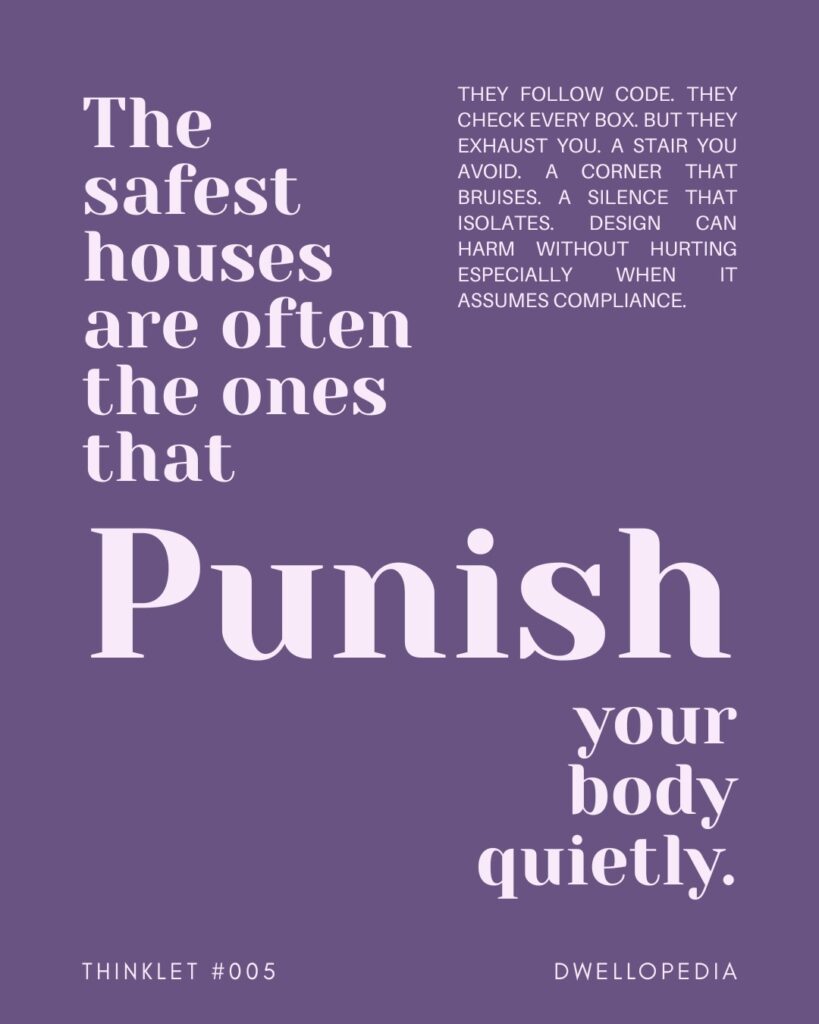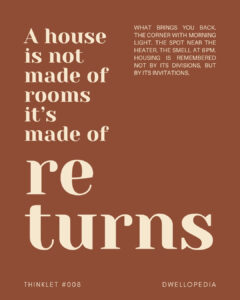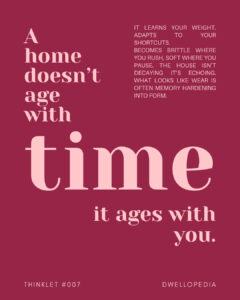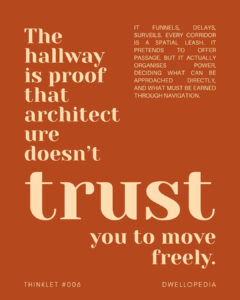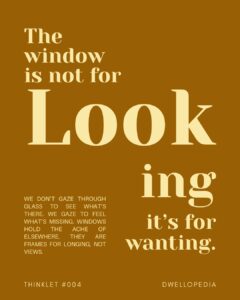The architecture of safety often wears a quiet mask—a facade of compliance, boxes checked, regulations met. Yet beneath this veneer, a more insidious reality can dwell. The safest houses are often the ones that punish your body quietly. They exhaust rather than ease, constrict rather than liberate. A stair you hesitate to climb, a hallway where your shoulder brushes the wall unnoticed, a corner that leaves its bruise only you feel—these are not accidental flaws but the subtle consequences of design that assumes perfect compliance, forgetting the lived body in motion.
What does it mean for a home to be truly safe? Is safety merely the absence of injury, or is it the presence of ease, of comfort that nurtures body and spirit? How often do we accept the quiet fatigue imposed by spatial design—an overlooked weight pressing on daily life? In housing, where our most intimate movements unfold, such small violences accumulate, shaping experience in ways regulations cannot capture.
Consider the unspoken choreography of movement through space: the quickening pulse on stairs too steep, the tense posture navigating narrow corridors, the silent negotiation of corners that bite and bruise. How does this bodily dialogue with architecture influence our sense of well-being, belonging, and freedom? Might safety be reimagined not as mere containment but as liberation—design that honors lived movement, softness, and ease?
This thinklet invites architects and thinkers to engage with the invisible burdens quietly borne in “safe” spaces. It beckons us to question the limits of codes and to envision housing that frees the body rather than tires it.
Housing Unfolded: Transforming the Practice
Embracing the idea that safe houses can be quietly punishing demands a profound reorientation of housing design practice. Beyond the checklist of codes and standards lies a complex realm of bodily experience, emotion, and subtle spatial interaction that shapes how we inhabit our homes. What might it mean for architects to design safety not only as protection from harm but as the promotion of ease, grace, and flow?
The physical choreography of daily life becomes a critical focus. Imagine stairs designed not just to prevent falls but to ease ascent and descent, considering muscle fatigue and comfort in every step. Picture hallways wide enough to allow free movement without bodily compromise, corners rounded not only for visual softness but for physical gentleness. How might such attention to the body’s lived movement transform housing from rigid enclosure into a fluid, nurturing environment?
Materiality also plays a vital role. Surfaces that respond with warmth or give subtly under pressure might ease tension; textures can soothe rather than abrade. Light and shadow animate space, not only visually but through warmth and contrast, supporting bodily rhythms and comfort. Could we imagine homes where every detail—from doorknobs to thresholds—invites bodily ease, where softness is a design imperative equal to safety compliance?
Social and cultural dimensions emerge here, too. Safety that exhausts the body isolates, detaching inhabitant from space and from others. A house that punishes silently becomes a site of quiet oppression, especially for those with different abilities, ages, or rhythms. How can housing design become inclusive in its attentiveness to embodied diversity, fostering belonging rather than fatigue? Might this challenge dominant narratives of “safe” housing as merely code-compliant enclosure?
Design thinking must expand to integrate empathy, body-awareness, and lived experience as core values. Architects become custodians not only of space but of bodily ease, crafting environments that listen to inhabitants’ movements and needs. This calls for iterative processes, sensitive to feedback and change, honoring imperfection and complexity rather than imposing rigid control.
Ripple effects touch urban and environmental scales as well. Housing that nurtures bodily ease contributes to healthier, more resilient communities. It challenges the reduction of safety to mere hazard prevention and reclaims it as holistic well-being. How might neighborhoods and cities embody this expanded vision of safety, fostering environments that ease rather than exhaust bodies?
In this unfolding, the very practice of housing design becomes a practice of care, intimacy, and ethical responsibility—moving from static codes to dynamic dialogues between body, space, and community.
Beyond Boundaries: Layered Understandings
The notion that safe houses can be quietly cruel reverberates through multiple interpretive lenses. Sustainability urges us to see embodied ease as integral to ecological design. Homes that demand less physical strain promote energy conservation and human resilience. Could softer, more responsive environments align with sustainable living goals, balancing human and planetary needs?
Social equity perspectives highlight how silent bodily burdens disproportionately affect marginalized groups—elderly, disabled, caregivers. Safety that tires is exclusionary. How might inclusive design practices account for varied embodied experiences, fostering dignity and autonomy? Can housing codes evolve to measure not only fall risk but fatigue and comfort, acknowledging diverse bodies and abilities?
Memory and identity enrich this dialogue. Spaces that silently punish can leave lasting imprints—bodily discomfort woven into daily routines, shaping how inhabitants remember and relate to home. How can architects design for positive bodily memories, spaces that nurture and heal rather than drain?
Technology offers new possibilities and challenges. Smart environments can monitor and adapt to bodily needs, potentially easing strain. Yet, they risk reducing experience to data, flattening rich embodied interaction. How might technology be harnessed to enhance bodily ease without sacrificing poetic and sensory depth?
Each perspective reveals the thought’s complexity, urging architects to embrace ambiguity and nuance. Safety must be understood not as a singular standard but as a layered, dynamic quality interwoven with body, culture, and environment.
Conclusion
To say the safest houses often quietly punish the body is to expose the hidden tensions within architectural care. This thinklet sows a seed for architects and thinkers to rethink safety—not as sterile compliance but as bodily freedom, softness, and respect.
In those unnoticed bruises, in the stairs we avoid and the hallways that constrain, lies an invitation: to design homes that honor lived movement, celebrate embodied diversity, and foster well-being beyond regulation. The home should be a refuge not just from harm, but from fatigue—a place that sustains body and soul alike.
As you ponder this thought, consider: How might your design practice cultivate safety that liberates rather than confines? How will you listen to the silent dialogues of bodies moving through space?
The power of this thinklet is not in answers but in its call to wonder and reimagine. What will it mean to create truly safe homes—spaces where bodies are free to move, rest, and flourish without quiet punishment?

